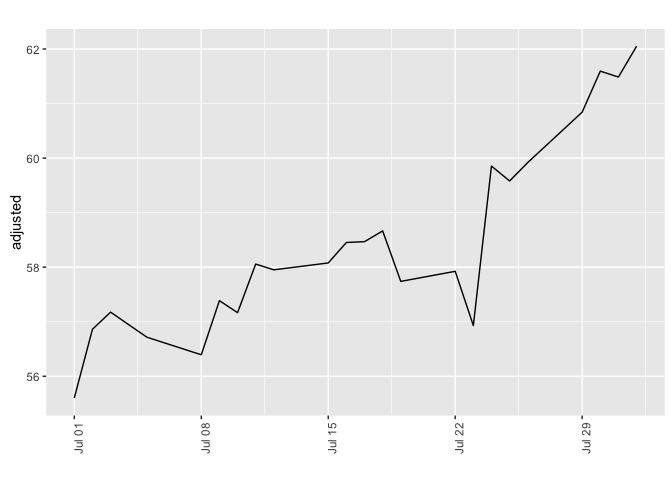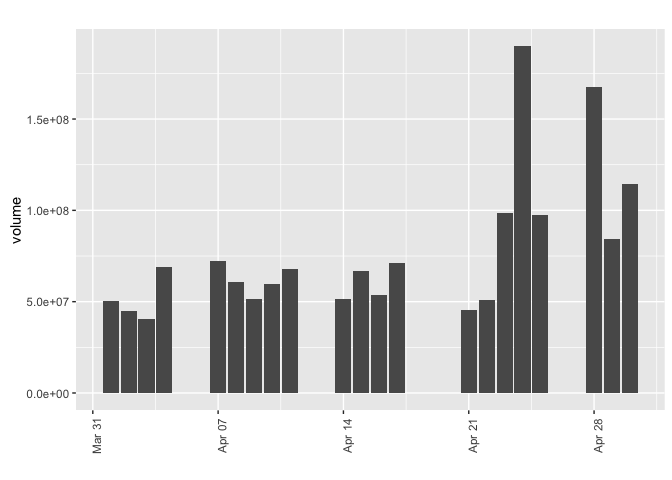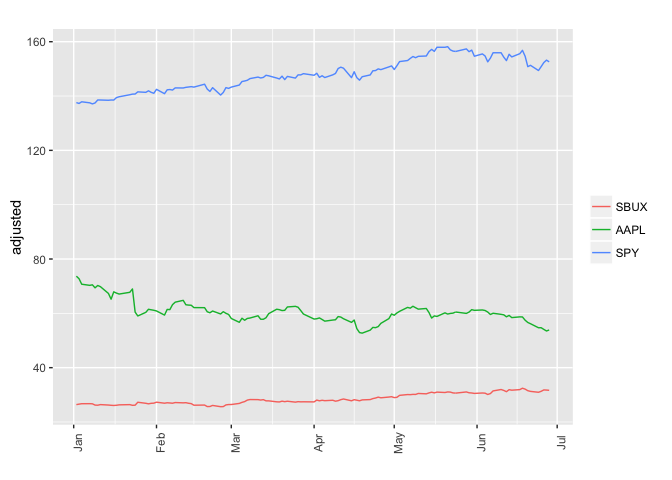Updated on Tue Dec 29 10:47:56 2015
FinCal – Time Value of Money, time series analysis and Computational Finance
FinCal is available on [CRAN] (http://cran.r-project.org/web/packages/FinCal/) and GitHub
install.packages("FinCal",dependencies=TRUE) # from CRAN
or
library("devtools")
install_github("felixfan/FinCal") # from GitHub
library(FinCal)
Note: for all examples, cash inflows are positive and outflows are negative.
Examples for version 0.1 -0.6
Example 1 Computing effective annual rate (EAR)
Using a stated rate of 4.25%, compute EARs for semiannual, quarterly, monthly, daily and continuous compounding.
ear(0.0425,2)
[1] 0.04295156
ear(0.0425,4)
[1] 0.04318215
ear(0.0425,12)
[1] 0.04333772
ear(0.0425,365)
[1] 0.04341347
ear.continuous(0.0425)
[1] 0.04341606
Example 2 Future value (FV) of a single sum
Calculate the FV of a $500 investment at the end of ten years if it earns an annually compounded rate of return of 6%.
fv.simple(r=0.06,n=10,pv=-500)
[1] 895.4238
Example 3 PV of a single sum
Given a discount rate of 3%, calculate the PV of a $1,000,000 cash flow that will be received in five years.
pv.simple(r=0.03,n=5,fv=1000000)
[1] -862608.8
Example 4 FV of an ordinary annuity and annuity due
What is the future value of an ordinary annuity that pays $15,000 per year at the end of each of the next 25 years, given the investment is expected to earn a 6% rate of return?
fv.annuity(r=0.06,n=25,pmt=-15000,type=0)
[1] 822967.7
What is the future value of an annuity that pays $10,000 per year at the beginning of each of the next three years, commencing today, if the cash flows can be invested at an annual rate of 5%?
fv.annuity(r=0.05,n=3,pmt=-10000,type=1)
[1] 33101.25
Example 5 PV of an ordinary annuity and annuity due
What is the PV of an annuity that pays $20,000 per year at the end of each of the next 25 years, given a 6% discount rate?
pv.annuity(r=0.06,n=25,pmt=-20000,type=0)
[1] 255667.1
Given a discount rate of 10%, what is the present value of a 10-year annuity that makes a series of $1000 payments at the beginning of each of the next three years, starting today?
pv.annuity(r=0.1,n=10,pmt=-1000,type=1)
[1] 6759.024
Example 6 PV of a perpetuity
A preferred stock that will pay $2.50 per year in annual dividends beginning next year and plans to follow this dividend policy forever. Given an 10% rate of return, what is the value of this preferred stock today?
pv.perpetuity(r=0.1,pmt=2.5,type=0)
[1] -25
Example 7 Rate of return for a perpetuity
Using the preferred stock described in the preceding example, determine the rate of return that an investor would realize if she paid $75 per share for the stock.
r.perpetuity(pmt=2.5,pv=-75)
[1] 0.03333333
Example 8 PV of a bond’s cash flows
A bond will make coupon interest payments of 70 HK$ (7% of its face value) at the end of each year and will also pay its face value of 1,000 HK$ at maturity in 10 years. If the appropriate discount rate is 6%, what is the present value of the bond’s promised cash flows?
pv(r=0.06,n=10,fv=1000,pmt=70,type=0)
[1] -1073.601
Example 9 Computing the FV and PV of an uneven cash How series
Using a rate of return of 6%, compute the future value of the 6-year uneven cash flow stream occured at the end of each year. (-10000 -5000 2000 4000 6000 8000)
fv.uneven(r=0.06, cf=c(-10000, -5000, 2000, 4000, 6000, 8000))
[1] -1541.791
Compute the present value of this 6-year uneven cash How stream described above using a 10% rate of return.
pv.uneven(r=0.1, cf=c(-10000, -5000, 2000, 4000, 6000, 8000))
[1] 747.1377
Example 10 Loan payment calculation: Annual payments and Quarterly payments
A company plans to borrow $500,000 for five years. The company’s bank will lend the money at a rate of 6% and requires that the loan be paid off in five equal end-of-year payments. Calculate the amount of the payment that the company must make in order to fully amortize this loan in five years.
pmt(r=0.06,n=5,pv=500000,fv=0)
[1] -118698.2
Example 11 Computing the number of periods in an annuity
How many $1000 end-of-year payments are required to accumulate $10,000 if the discount rate is 9%?
n.period(r=0.09,pv=0,fv=10000,pmt=-1000,type=0)
[1] 7.448028
Example 12 Computing the rate of return for a period
Suppose you have the opponunity to invest $1000 at the end of each of the next five years in exchange for $6000 at the end of the fifth year. What is the annual rate of return on this investment?
discount.rate(n=5,fv=6000,pmt=-1000,pv=0,type=0)
[1] 0.09130091
Example 13 Computing NPV
Calculate the NPV of an investment project with an initial cost of $6 million and positive cash flows of $2.6 million at the end of Year 1, $2.4 million at the end of Year 2, and $3.8 million at the end ofYear 3. Use 8% as the discount rate.
npv(r=0.08, cf=c(-6,2.6,2.4,3.8))
[1] 1.481583
Example 14 Computing IRR
What is the IRR for the investment described in example 13?
irr(cf=c(-6,2.6,2.4,3.8))
[1] 0.2032579
Example 15 Computing HPR
Suppose a stock is purchased for $3 and is sold for $4 six months later, during which time it paid $0.50 in dividends. What is the holding period return?
hpr(ev=4,bv=3,cfr=0.5)
[1] 0.5
Example 16 Computing time-weighted rate of return
An investor purchases a share of stock at t = 0 for $10. At the end of the year, t = 1 , the investor buys another share of the same stock for $12. At the end of Year 2, the investor sells both shares for $13 each. At the end of both years 1 and 2, the stock paid a $1 per share dividend. What is the annual time-weighted rate of return for this investment?
twrr(ev=c(12,26),bv=c(10,24),cfr=c(1,2))
[1] 0.2315302
Example 17 Computing Bank discount yield
Calculate the bank discount yield for a T-hill priced at $9,850, with a face value of $10,000 and 120 days until maturity.
bdy(d=150,f=10000,t=120)
[1] 0.045
Example 18 Convert holding period return to the effective annual rate
Compute the EAY using the 120-day HPY of 2.85%.
hpr2ear(hpr=0.0285,t=120)
[1] 0.08923453
Example 19 Computing money market yield
What is the money market yield for a 120-day T-bill that has a bank discount yield of 4.50%?
bdy2mmy(bdy=0.045,t=120)
[1] 0.04568528
Example 20 Converting among EAR, HPY, and MMY
Assume the price of a $10,000 T-hill that matures in 150 days is $9,800. The quoted money market yield is 4.898%. Compute the HPY and the EAR.
hpr(ev=10000,bv=9800)
[1] 0.02040816
mmy2hpr(mmy=0.04898,t=150)
[1] 0.02040833
hpr2ear(hpr=mmy2hpr(mmy=0.04898,t=150),t=150)
[1] 0.05038874
ear2hpr(ear=hpr2ear(hpr=mmy2hpr(mmy=0.04898,t=150),t=150),t=150)
[1] 0.02040833
Example 21 Bond-equivalent yield calculation
What is the yield on a bond-equivalent basis of a 3-month loan has a holding period yield of 4%?
hpr2bey(hpr=0.04,t=3)
[1] 0.1632
What is the yield on a bond-equivalent basis of an investment with 6% effective annual yield?
ear2bey(ear=0.06)
[1] 0.05912603
Example 22 Weighted mean as a portfolio return
A portfolio consists of 40% common stocks, 50% bonds, and 10% cash. If the return on common stocks is 9%, the return on bonds is 6%, and the return on cash is 1%, what is the portfolio return?
wpr(r=c(0.09, 0.06, 0.01),w=c(0.4,0.5,0.1))
[1] 0.067
or
rs=c(0.09, 0.06, 0.01)
ws=c(0.4,0.5,0.1)
wpr(r=rs,w=ws)
[1] 0.067
Example 23 Geometric mean return
For the last three years, the returns for Acme Corporation common stock have been -5%, 11%, and 9%. Compute the compound annual rate of return over the 3-year period.
geometric.mean(r=c(-0.05, 0.11, 0.09))
[1] 0.04750883
Example 24 Calculating average cost with the harmonic mean
An investor purchases $10,000 of stock each month, and over the last three months the prices paid per share were $4.5, $5.2, and $4.8. What is the average cost per share for the shares acquired?
harmonic.mean(p=c(4.5,5.2,4.8))
[1] 4.816467
Example 25 Download historical financial data from Yahoo finance and Google Finance
Download historical financial data from Yahoo finance
apple <- get.ohlc.yahoo(symbol="AAPL",start="2013-07-01",end="2013-08-01")
head(apple)
date open high low close volume adjusted
23 2013-07-01 402.69 412.27 401.22 409.22 97763400 55.60200
22 2013-07-02 409.96 421.63 409.47 418.49 117466300 56.86155
21 2013-07-03 420.86 422.98 417.45 420.80 60232200 57.17542
20 2013-07-05 420.39 423.29 415.35 417.42 68506200 56.71616
19 2013-07-08 420.11 421.00 410.65 415.05 74534600 56.39415
18 2013-07-09 413.60 423.50 410.38 422.35 88146100 57.38602
Download historical financial data from Google Finance
apple <- get.ohlc.google(symbol="AAPL",start="2013-07-01",end="2013-08-01")
head(apple)
date open high low close volume
23 2013-07-01 57.53 58.90 57.32 58.46 97793045
22 2013-07-02 58.57 60.23 58.50 59.78 117521579
21 2013-07-03 60.12 60.43 59.64 60.11 60232158
20 2013-07-05 60.06 60.47 59.34 59.63 68520760
19 2013-07-08 60.02 60.14 58.66 59.29 74578420
18 2013-07-09 59.09 60.50 58.63 60.34 88172238
Download multiple historical financial data from Yahoo finance
applespy <- get.ohlcs.yahoo(symbols=c("AAPL","SPY"),start="2013-01-01",end="2013-07-31")
head(applespy$AAPL)
date open high low close volume adjusted
146 2013-01-02 553.82 555.00 541.63 549.03 140129500 73.67851
145 2013-01-03 547.88 549.67 541.00 542.10 88241300 72.74852
144 2013-01-04 536.97 538.63 525.83 527.00 148583400 70.72214
143 2013-01-07 522.00 529.30 515.20 523.90 121039100 70.30613
142 2013-01-08 529.21 531.89 521.25 525.31 114676800 70.49535
141 2013-01-09 522.50 525.01 515.99 517.10 101901100 69.39359
head(applespy$SPY)
date open high low close volume adjusted
146 2013-01-02 145.11 146.15 144.73 146.06 192059000 137.5859
145 2013-01-03 145.99 146.37 145.34 145.73 144761800 137.2750
144 2013-01-04 145.97 146.61 145.67 146.37 116817700 137.8779
143 2013-01-07 145.85 146.11 145.43 145.97 110002500 137.5011
142 2013-01-08 145.71 145.91 144.98 145.55 121265100 137.1055
141 2013-01-09 145.87 146.32 145.64 145.92 90745600 137.4540
Download multiple historical financial data from Google Finance
all <- get.ohlcs.google(symbols=c("YHOO","SPY", "SINA"),start="2013-01-01",end="2013-07-31")
head(all$YHOO)
date open high low close volume
146 2013-01-02 20.20 20.32 20.01 20.08 20463033
145 2013-01-03 20.05 20.10 19.72 19.78 19599094
144 2013-01-04 19.76 19.95 19.72 19.86 12489700
143 2013-01-07 19.56 19.58 19.28 19.40 23866609
142 2013-01-08 19.32 19.68 19.30 19.66 16932176
141 2013-01-09 19.73 19.75 19.22 19.33 21656278
head(all$SPY)
date open high low close volume
146 2013-01-02 145.11 146.15 144.73 146.06 192058911
145 2013-01-03 145.99 146.37 145.34 145.73 144761781
144 2013-01-04 145.97 146.61 145.67 146.37 116817675
143 2013-01-07 145.85 146.44 145.43 145.97 110002444
142 2013-01-08 145.71 145.91 144.98 145.55 121265078
141 2013-01-09 145.87 146.32 145.64 145.92 90745581
head(all$SINA)
date open high low close volume
146 2013-01-02 52.24 55.19 51.75 52.27 3947513
145 2013-01-03 52.34 53.61 51.54 52.77 2200712
144 2013-01-04 52.70 52.94 51.70 52.76 1466652
143 2013-01-07 51.81 52.67 51.40 52.57 1368991
142 2013-01-08 52.20 53.00 51.41 51.81 1381026
141 2013-01-09 51.76 52.43 50.61 51.54 2098518
Example 26 Plots open-high-low-close chart of (financial) time series.
Line chart
apple <- get.ohlc.yahoo(symbol="AAPL",start="2013-07-01",end="2013-08-01")
lineChart(apple,y="adjusted")

Candlestick chart
apple <- get.ohlc.yahoo(symbol="AAPL",start="2013-07-01",end="2013-08-01")
candlestickChart(apple,y="adjusted")

Volume chart
apple <- get.ohlc.yahoo("AAPL",start="2014-04-01",end="2014-04-30")
volumeChart(apple,y="adjusted")

Multiple line chart
all <- get.ohlcs.yahoo(c("SBUX","AAPL","SPY"),start="2013-01-01",end="2013-06-30")
lineChartMult(all,y="adjusted")

Examples 27 Inventory Expense Recognition – cost of goods sold
Three methods: first-in, first-out (FIFO) method; last-in, first-out (LIFO) method; weighted average cost method.
e.g. during one month beginning inventory: 20 units @ $2/unit buy : 30 units @ $3/unit buy : 50 units @ $5/unit sold : 70 units what is the cost of goods sold using three menthod?
# first-in, first-out (FIFO) method
cogs(uinv=20,pinv=2,units=c(30,50),price=c(3,5),sinv=70,method="FIFO")
$costOfGoods
[1] 230
$endingInventory
[1] 150
# last-in, first-out (LIFO) method
cogs(uinv=20,pinv=2,units=c(30,50),price=c(3,5),sinv=70,method="LIFO")
$costOfGoods
[1] 310
$endingInventory
[1] 70
# weighted average cost method
cogs(uinv=20,pinv=2,units=c(30,50),price=c(3,5),sinv=70,method="WAC")
$costOfGoods
[1] 266
$endingInventory
[1] 114
Example 28 Depreciation Expense Recognition
Methods: straight line depreciation method, double-declining balance (DDB) e.g., One Company recently purchased a machine at a cost of $9,800. The machine is expected to have a residual value of $2,000 at the end of its useful life in five years. What is the depreciation expense for all five years using two different menthods?
# straight line depreciation method
slde(cost=9800,rv=2000,t=5)
[1] 1560
# double-declining balance (DDB)
ddb(cost=9800,rv=2000,t=5)
t ddb
[1,] 1 3920.0
[2,] 2 2352.0
[3,] 3 1411.2
[4,] 4 116.8
[5,] 5 0.0
Example 29 Weighted average shares and EPS
One company has net income of $100,000 and paid $10,000 cash dividends to its preferred shareholders and $10,750 cash dividends to its common shareholders. At the beginning of the year, there were 20,000 shares of common stock outstanding. 20,000 new shares were issued on July 1 . what is the weighted average shares and basic EPS?
# weighted average shares
was=was(ns=c(20000,20000),nm=c(12,6))
was
[1] 30000
# basic EPS
EPS(ni=100000,pd=10000,w=was)
[1] 3
One company has 15,000 shares outstanding all year. It had 2,000 outstanding warrants all year, convertible into one share each at $20 per share. The year-end price of stock was $40, and the average stock price was $30. What effect will these warrants have on the weighted average number of shares?
iss(amp=30,ep=20,n=2000)
[1] 666.6667
During 2013, X reported net income of $231,200 and had 400,000 shares of common stock outstanding for the entire year. X had 2,000 shares of 10%, $100 par convertible preferred stock, convertible into 40 shares each, outstanding for the entire year. X also had 1200, 7%, $1,000 par value convertible bonds, convertible into 100 shares each, outstanding for the entire year. Finally, X had 20,000 stock options outstanding during the year. Each option is convertible into one share of stock at $15 per share. The average market price of the stock for the year was $20. The tax rate is 40%. What are X’s basic and diluted EPS?
EPS(ni=231200,pd=2000*0.1*100,w=400000)
[1] 0.528
iss=iss(amp=20,ep=15,n=20000)
diluted.EPS(ni=231200,pd=2000*0.1*100,cpd=2000*0.1*100,cdi=1200*0.07*1000,tax=0.4,w=400000,cps=2000*40,cds=1200*100,iss=iss)
[1] 0.4654545